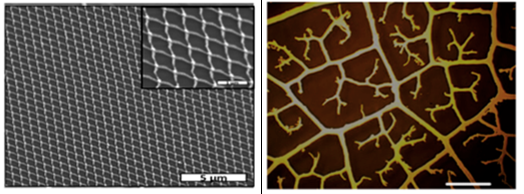Nanotechnology for energy materials: Electrodes like leaf veins

Nano-sized metallic wires are attracting increasing attention as conductive elements for manufacturing transparent electrodes, which are employed in solar cells and touch screen panels. In addition to high electric conductivity, excellent optical transmittance is one of the important parameters for an electrode in photovoltaic applications.
An international team headed by HZB scientist Prof. Michael Giersig has recently demonstrated for these applications that networks of metallic mesh possessing fractal-like nano-features surpass other metallic networks in utility. These findings have now been published in the most recent edition of the renowned journal Nature Communications.
Their new development is based on what is termed quasi-fractal nano-features. These structures have similarities to the hierarchical networks of veins in leaves. Giersig's team was able to show that metallic networks with these features optimise performance of electrodes for several applications. They combine minimized surface coverage with ultra-low total resistance while maintaining uniform current density. In addition, it was demonstrated that these networks, inspired by nature, can surpass the performance of conventional indium tin oxide (ITO) layers. In experiments on artificially constructed electrode networks of different topologies, the scientists established that non-periodic hierarchical organisation exhibited lower resistance as well as excellent optical transmittance in comparison to periodic organisation. This led to elevated output power for photovoltaic components.
"On the basis of our studies, we were able to develop an economical transparent metal electrode", says Giersig, continuing "We obtain this by integrating two silver networks. One silver network is applied with a broad mesh spacing between the micron-diameter main conductors that serve as the "highway" for electrons transporting electrical current over macroscopic distances." Next to it, additional randomly distributed nano-wire networks serve as local conductors to cover the surface between the large mesh elements. "These smaller networks act as regional roadways beside the highways to randomise the directions and strengths of the local currents, and also create refraction effects to improve transparency above that of classical shadow-limited performance", according to Giersig. "Solar cells based upon these electrodes show exceptional a high efficiencies".
More information: Bing Han et al, Optimization of hierarchical structure and nanoscale-enabled plasmonic refraction for window electrodes in photovoltaics, Nature Communications (2016). DOI: 10.1038/ncomms12825
Journal information: Nature Communications
Provided by Helmholtz Association of German Research Centres



















